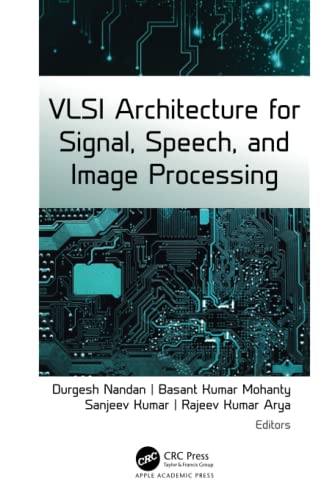VLSI Architecture for Signal Speech and Image Processing 1st Edition by Durgesh Nandan, Basant Kumar Mohanty, Sanjeev Kumar, Rajeev Kumar Arya ISBN 9781774637302 1774637308
$50.00 Original price was: $50.00.$25.00Current price is: $25.00.
VLSI Architecture for Signal Speech and Image Processing 1st Edition by Durgesh Nandan, Basant Kumar Mohanty, Sanjeev Kumar, Rajeev Kumar – Ebook PDF Instant Download/Delivery: 9781774637302 ,1774637308
Full download VLSI Architecture for Signal Speech and Image Processing 1st Edition after payment

Product details:
ISBN 10: 1774637308
ISBN 13: 9781774637302
Author: Durgesh Nandan, Basant Kumar Mohanty, Sanjeev Kumar, Rajeev Kumar
VLSI Architecture for Signal Speech and Image Processing 1st Edition Table of contents:
1. Evolution of 1-D, 2-D, and 3-D Lifting Discrete Wavelet Transform VLSI Architecture
1.1 Introduction
1.2 Types of Wavelets
1.2.1 1-Dimensional Architecture
1.2.2 2-Dimensional Architecture
1.2.3 3-Dimensional Architecture
1.3 Schemas for the Dwt Implementation
1.3.1 Lifting Scheme
1.3.2 Flipping Scheme
1.3.3 Convolution Scheme
1.4 Summary of the Architectures
1.5 Conclusion
References
2. Execution of Lifting-Scheme Discrete Wavelet Transform by Canonical Signed Digit Multiplier
2.1 Introduction
2.2 Lifting Scheme Discrete Wavelet Transform (Dwt)
2.3 Shift-Add Multip Lier
2.4 Multiplier Using Canonical Signed Digit
2.4.1 Characteristics of Csd Representation
2.5 Proposed Csd Multiplier
2.6 Synthesis Results
2.7 Conclusion
References
3. Radix-8 Booth Multiplier in Terms of Power and Area Efficient for Application in Field of 2D DWT Architecture
3.1 Introduction
3.2 Existing Booth Multiplier
3.2.1 Partial Products Structure
3.2.2 Booth Encoder (Be) and Selector Units
3.3 Proposed Booth Multiplier
3.3.1 Method Of Implementation
3.3.2 Partial Product Array (Ppa) Structure
3.3.3 Steps Involved
3.3.4 Theoretical Analysis Showing With An Example
3.4 Implementation of 2D Dwt Using Proposed Booth Multiplier Using Dwt
3.4.1 Implementation Of Existing 2D Dwt Architecture
3.4.2 Implementing 1D Dwt Architectures Using Proposed Booth Multiplier
3.5 Synthesis Results
3.6 Conclusion and Future Scope
References
4. Design and Performance Evaluation of Energy Efficient 8-Bit ALU at Ultra-Low Supply Voltages Using FinFET with 20 nm Technology
4.1 Introduction
4.2 Finfet Characteristics and Modeling
4.3 Proposed 8 Bit Alu Block Using Finfet Models
4.3.1 Gdi-Based Multiplexer
4.3.2 11T Full Adder
4.3.3 1-Bit and 8-Bit Alu
4.4 Simulation Results and Experimental Findings of the Proposed Work
4.5 Conclusion
References
5. Design and Statistical Analysis of Strong Arbiter PUFs for Device Authentication and Identification
5.1 Introduction
5.2 Background
5.2.1 Operation of Ring Oscillator PUF
5.2.2 Operation of Arbiter PUF
5.3 Architecture and Simulation
5.3.1 Proposed Mux-Decoder Based 16-Stage Arbiter PUF
5.3.2 PUF Security Metrics
5.4 Conclusion
References
6. An Impact of Aging on Arbiter Physical Unclonable Functions
6.1 Introduction
6.2 Metrics of PUF
6.2.1 Uniqueness
6.2.2 Reliability
6.2.3 Uniformity
6.3 Related Work
6.3.1 Effect of Temperature on Reliability of the PUF
6.3.2 Aging Mechanisms on Reliability of the PUF
6.3.3 Negative Bias Temperature Instability (NBTI)
6.3.4 Hot Carrier Injection (HCI)
6.3.5 Time-Dependent Dielectric Breakdown (TDDB)
6.3.6 Sources of Soft Errors in CMOS ICS
6.3.7 Radiation-Induced Soft Errors
6.3.8 Cross Talk Noise
6.3.9 Ground Bounce
6.4 Arbiter Pufs
6.4.1 Architecture and Operation of Arbiter PUFs
6.4.2 Mathematical Modeling of Arbiter PUF
6.4.3 Estimation of Aging on Arbiter PUFs
6.4.4 Aging Model for Arbiter Puf
6.4.5 Architecture of the Mux-Decoder PUF Architecture
6.4.6 Simulation Setup and Statistical Performance Analysis of Proposed PUF
6.5 Conclusion and Future Scope
References
7. Advanced Power Management Methodology for SoCs Using UPF
7.1 Introduction
7.2 Mathematical Modeling
7.2.1 Dynamic Power Dissipation
7.2.2 Signal Switching Power
7.2.3 Short Circuit Power
7.3 Static Power
7.4 Low Power Design
7.4.1 Clock Gating
7.4.2 Power Gating
7.4.3 Multi-Voltage Design
7.4.4 Voltage/Frequency Scaling
7.5 Need of Verification
7.6 Upf or Ieee 1801
7.7 UPF: Fundamental Modeling Constructs
7.8 Apb Description
7.8.1 Apb Protocol
7.9 APB Protocol Power Management Architecture
7.9.1 APB Implementation
7.9.2 Operating Modes
7.10 Simulation Results
7.11 Conclusion
Acknowledgment
References
8. Architecture Design: Network-on-Chip
8.1 Block of Data Format
8.2 Exchanging Methods
8.2.1 Circuit Exchanging
8.2.2 Block of Data Exchanging
8.2.3 Combinations of Different Exchanging
8.3 Asynchronous Fifo Implementation
8.3.1 Design of an Asynchronous Fifo Through Gray Code Counters
8.4 Gals Style of Communication
8.5 Wormhole Routing
8.6 Fundamental Channel (VC) Data Forwarding Device Architecture Design
8.7 Conclusion
References
9. Routing Strategy: Network-on-Chip Architectures
9.1 Packet Routing
9.2 Quality of Service (QoS)
9.3 Packet Flow Through a Typical Qos Policy
9.3.1 Qos Deployment Lifecycle
9.3.2 QoS Construction Workflow
9.3.3 Qos Configuration Workflow ((C))
9.3.4 QoS Tools
9.3.5 Classification and Marking
9.3.6 Queuing
9.3.7 Shaping and Policing
9.3.8 Wan Traffic Shaping
9.4 Congestion Control for Network on Chip
9.5 Flow Control in NOC
9.5.1 Flow Control
9.5.2 Circuit Switching
9.5.3 Flow Control
9.5.4 Data Unit
9.6 Router Design
9.6.1 Xy Routing Algorithm
9.6.2 Surrounding XY Routing
9.6.3 Oe Routing Algorithm
9.7 Designed NOC Links
9.7.1 Link Efficiency Mechanisms
9.8 Multicast Routing Schemes
9.8.1 Tree-Based Multicast
9.8.2 Path-Based Multicast
9.8.3 Path-Based Multicast Routing for 2D
9.8.4 Architecture of NOC
9.8.5 Design of NOC
9.8.6 Routing Algorithm for 2×2 Networks
9.8.7 Format Of Packet Formatting In 2D Routing
9.9 Fault-Tolerant Routing Algorithms
9.9.1 Routing and Reliable that is Adaptive Algorithms
9.10 Conclusion
References
10. Self-Driven Clock Gating Technique for Dynamic Power Reduction of High-Speed Complex Systems
10.1 Introduction
10.2 Related Work
10.3 Self-Driven Clock Gating
10.4 Methodology
10.5 Implementation of Clock Gating on 32-Bit Risc Processor
10.6 Simulation Results
10.7 Implementation
10.8 Results and Discussions
10.9 Conclusion
References
11. Optimization of SOC Sub-Circuits Using Mathematical Modeling
11.1 Introductory Note
11.2 System-On-Chip
11.3 Study of Device-Circuit Integration
11.3.1 Design Metrics
11.3.2 Analog and RF Metrics
11.4 Motivation
11.4.1 Scope of Work
11.4.2 Classical Optimization
11.4.3 Knowledge-Based Optimization
11.4.4 Global Optimization
11.4.5 Convex Optimization and Geometric Programming
11.4.6 Observations
11.5 Introduction To Geometric Programming
11.5.1 Standard Representation
11.5.2 Monomial And Posynomial Functions
11.5.3 Execution Process
11.5.4 Test of Feasibility, Trade-Off, and Sensitivity
11.5.5 Generalized Geometric Program
11.5.6 Software Package
11.5.7 Optimization Process Flow
11.6 Optimization of Biomedical Cmos Low-Noise Amplifier
11.6.1 Low-Noise Amplifier Topology
11.6.2 Formulation of Neural Recording Amplifier
11.6.3 Result Interpretation
11.6.4 Inferences
References
12. An Efficient Design of D Flip Flop in Quantum-Dot Cellular Automata (QCA) for Sequential Circuits
12.1 Introduction
12.2 QCA Majority Implementation
12.3 Quantum-Dot Cellular Automata Based Flip Flop Design
12.3.1 Jk Flip Flop
12.3.2 T Flip Flop
12.3.3 Sr Flip Flop
12.3.4 D Flip Flop
12.4 Shift Register Using D-Ff
12.5 Ring Counter Using D-Ff
12.6 Conclusion
References
13. Design and Performance Analysis of Controlled DC-DC Converter
13.1 Introduction
13.2 Digital Voltage Mode Control Of Dc-Dc Converter
13.3 Design And Modeling Of Dc-Dc Buck Converter
13.4 Digital Compensator
13.5 Pulse Width Modulation (PWM)
13.5.1 Analog Implementation of Pulse Width Modulation (PWM)
13.6 Digital Pulse Width Modulation (DPWM)
13.7 Simulation Results
13.7.1 Experimental Verification
13.8 Conclusion
References
Index
People also search for VLSI Architecture for Signal Speech and Image Processing 1st Edition:
image processing using vlsi
vlsi digital signal processing keshab k parhi pdf
vlsi signal
vlsi signal processing lab
vlsi architecture in dsp
Tags: Durgesh Nandan, Basant Kumar Mohanty, Sanjeev Kumar, Rajeev Kumar Arya, VLSI Architecture, Signal, Speech, Image Processing
You may also like…
Mathematics - Wavelets and signal processing
High-Resolution Noisy Signal and Image Processing 1st Edition Igor Zurbenko
Education Studies & Teaching - Studying & Test Preparation
Computers - Artificial Intelligence (AI)
Technique - Electronics: Signal Processing
Medicine - Medicine & Nursing Reference
Computers - Cybernetics










